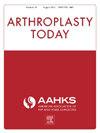前路保肌入路是安全有效的全髋关节置换术
IF 2.1
Q3 ORTHOPEDICS
引用次数: 0
摘要
背景:先前髋臼或髋臼骨折固定后的全髋关节置换术(THA)被认为比初次髋关节置换术风险更高,因为研究表明植入物存活率降低,感染率更高。前基肌肉保留(ABMS)入路可以通过利用新的手术间隔来潜在地减少这些风险。本研究的目的是比较ABMS入路与后路入路在骨折固定后转髋关节置换术的疗效。方法:本回顾性队列研究纳入了2013年至2020年间1家机构的既往髋关节手术干预患者,这些患者需要使用硬体植入,然后使用ABMS或后路入路转换为THA。研究的结果包括术后并发症、30天急诊科就诊、90天再入院率、任何再手术和患者报告的结果测量。结果ABMS组85例(男51例,女34例),后路组17例(男9例,女8例)。ABMS组平均年龄为65.6岁(±16.2岁),平均体重指数为27.5 kg/m2(±5.4)。平均手术时间85分钟(±35),估计失血量178 mL(±183)。术后90天内发生1例并发症(脱位),30天内急诊1例,90天内再入院3例;只有1例是骨科再入院。在5.0年(±2.1年)的研究期间,1例患者需要再手术(1.2%)。患者报告的结果显示功能恢复成功。接受ABMS和后路入路的患者的手术、住院和结局数据相似。本研究首次评估了采用ABMS入路与后路相比较的THA转归效果。我们机构的经验表明,ABMS入路是安全有效的,用于先前骨折固定后的THA转换。本文章由计算机程序翻译,如有差异,请以英文原文为准。
The Anterior-Based Muscle-Sparing Approach for Conversion Total Hip Arthroplasty is Safe and Effective
Background
Total hip arthroplasty (THA) after prior hip or acetabular fracture fixation is considered higher risk than primary THA, as studies have shown reduced implant survival and higher infection rates. The anterior-based muscle-sparing (ABMS) approach can potentially reduce some of these risks by utilizing a new surgical interval. The goal of this study is to analyze the efficacy of the ABMS approach for conversion to hip arthroplasty surgery after previous fracture fixation with comparison to posterior approach.
Methods
This retrospective cohort study included patients with prior hip surgical intervention requiring hardware then converted to a THA using the ABMS or posterior approach at 1 institution between 2013 and 2020. Outcomes studied included postoperative complications, 30-day emergency department visits, 90-day readmission rates, any reoperation and patient-reported outcome measures.
Results
A total of 85 patients (51 male and 34 female) in the ABMS group and 17 patients (9 male and 8 female) in the posterior group were included. Within the ABMS group, the mean age was 65.6 years (±16.2) with a mean body mass index of 27.5 kg/m2 (±5.4). The average operative time was 85 minutes (±35) and estimated blood loss was 178 mL (±183). There was 1 postoperative complication (dislocation) within 90 days, 1 patient made an emergency department visit within 30 days, and there were 3 readmissions within 90 days; only 1 readmission was orthopaedic in nature. One patient required reoperation (1.2%) over the study period of 5.0 years (±2.1). Patient-reported outcome measures indicate successful return of function. Operative, hospital, and outcome data were similar between patients receiving the ABMS and posterior approach.
Conclusions
This study is the first to evaluate outcomes of conversion THA using the ABMS approach, when compared to the posterior approach. Our institution’s experience demonstrates that the ABMS approach is safe and effective for conversion THA after prior fracture fixation.
求助全文
通过发布文献求助,成功后即可免费获取论文全文。
去求助
来源期刊

Arthroplasty Today
Medicine-Surgery
CiteScore
2.90
自引率
0.00%
发文量
258
审稿时长
40 weeks
期刊介绍:
Arthroplasty Today is a companion journal to the Journal of Arthroplasty. The journal Arthroplasty Today brings together the clinical and scientific foundations for joint replacement of the hip and knee in an open-access, online format. Arthroplasty Today solicits manuscripts of the highest quality from all areas of scientific endeavor that relate to joint replacement or the treatment of its complications, including those dealing with patient outcomes, economic and policy issues, prosthetic design, biomechanics, biomaterials, and biologic response to arthroplasty. The journal focuses on case reports. It is the purpose of Arthroplasty Today to present material to practicing orthopaedic surgeons that will keep them abreast of developments in the field, prove useful in the care of patients, and aid in understanding the scientific foundation of this subspecialty area of joint replacement. The international members of the Editorial Board provide a worldwide perspective for the journal''s area of interest. Their participation ensures that each issue of Arthroplasty Today provides the reader with timely, peer-reviewed articles of the highest quality.
 求助内容:
求助内容: 应助结果提醒方式:
应助结果提醒方式:


